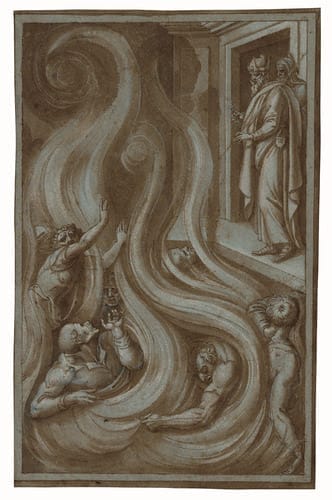NEW YORK—Christopher Bishop Fine Art will exhibit a newly discovered drawing from the 16th century at Master Drawings New York (MDNY) on view from January 27 through February 3, 2024, at Christopher Bishop Fine Art, 1046 Madison Avenue. The annual show, a well-established and highly anticipated art fair, which takes place in 26 galleries throughout Manhattan’s Upper East Side, will open with a preview event on Friday, January 26, from 3 p.m.- 8 p.m.
The extraordinarily rare Spanish drawing, The Pharoah’s Judgment, was first discovered by Christopher Bishop at a small New England auction earlier this year. “Its gripping subject matter and modern feel make it the type of drawing that only emerges once every 20 years,” Christopher Bishop stated. “A priceless object, worth more than 50 times its high estimate, The Pharaoh’s Judgment presents an extraordinary story of survival.”
Drawings such as The Pharoah’s Judgment are well documented as they remain in the Escorial collection, within the vast building complex in San Lorenzo de El Escorial, near Madrid, in central Spain. The most important architectural monument of the Spanish Renaissance, Escorial includes a church (1582); monastery, royal palace, and college (1584); and library (1592).
“The Pharoah’s Judgment offers a unique chance to understand a lost world,” noted Bishop. “It was made at the end of the 16th century in the Royal embroidery studio at the Escorial palace in Spain. King Philip II spared no expense when it came to his pet project, funneling huge wealth into the creation of ornate embroideries. The drawing’s rarity and importance only came to light when the drawing was lifted off of its old backing and its function and origins became clear as the light came through the pricks in the paper.”
The drawing has tiny pin-size prick holes along the whole pattern of the drawing, which would have been used to transfer the image to a piece of cloth. These holes are visible to the naked eye when held up to the light. The picture would then have been used to prepare an embroidery of the same size for a portion of a luxurious ecclesiastical garment.
Bishop added, “Imagine the dazzling display these embroideries must have made. Even this one scene, which must have been one of many on a priest’s vestments, would have taken months to weave and contained more silver and gold thread than the average Spaniard could hope to accumulate in a lifetime. The shock and awe of these garments must have been tremendous. The Spanish understood theological theater. Even the subject matter is chosen to impress the viewer with the power of the King. Fashion and religion seem like very different fields, but really, they have always been linked through a sense of theater and drama—just think of the Metropolitan Museum costume exhibition Heavenly Bodies on this theme.”
The Pharoah’s Judgment will be shown in a unique open double-sided frame in order to allow viewers to understand the ways in which its maker and the embroiderers collaborated in the process of constructing the garments.
“In the period, women did the embroidery work and one can imagine the many hours of anonymous work they did to complete this image,” Bishop explained. “Deep in the Escorial archives probably lies this very embroidery, the product of countless hours of unrecognized labor. With any luck and much patience, it might be found again. The recovery of these connections will allow us for the first time to put these female workers back into the story of art and make their presence known again. They were the ones who knew how to bring this scene to life in full technicolor.”
ABOUT MASTER DRAWINGS NEW YORK
Master Drawings New York (MDNY) is the premier U.S. drawings showcase, a well-established hybrid art fair/art walk on the Upper East Side of Manhattan. The 18th annual show in 2024 will be held January 27—February 3, with a preview on January 26. Highlighting important work from a key group of galleries known for their expertise, scholarship, and connoisseurship, the show is timed to coincide with the drawing auctions at Sotheby’s and Christie’s and the last few days of The Winter Show. Covering 40 city blocks, the week-long show, which began in 2006, presents approximately 24 galleries showing work from the 15th to the 21st centuries.
ABOUT CHRISTOPHER BISHOP FINE ART
Christopher Bishop Fine Art specializes in drawings and paintings from the 15th through early 20th century. Known for a scholarly approach to evaluating, presenting, and authenticating Old Master works as well as a wide range of works on paper, the gallery seeks to present new ways to think about and collect Old Masters and modern works on paper. Located at 1046 Madison Avenue at East 80th Street in New York City, the gallery participates in Master Drawings New York; TEFAF Maastricht; The Salon du Dessin, Paris; and October Art Week, New York. More information is available at christopherbishopfineart.com.
